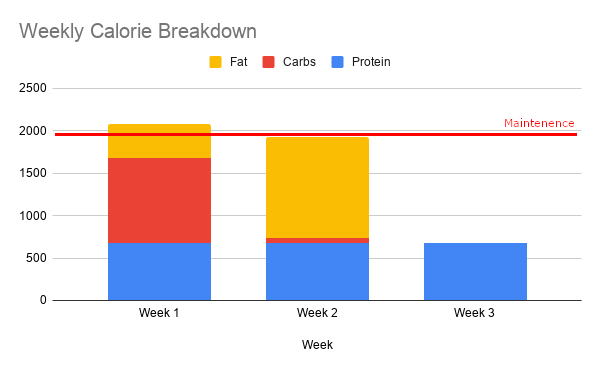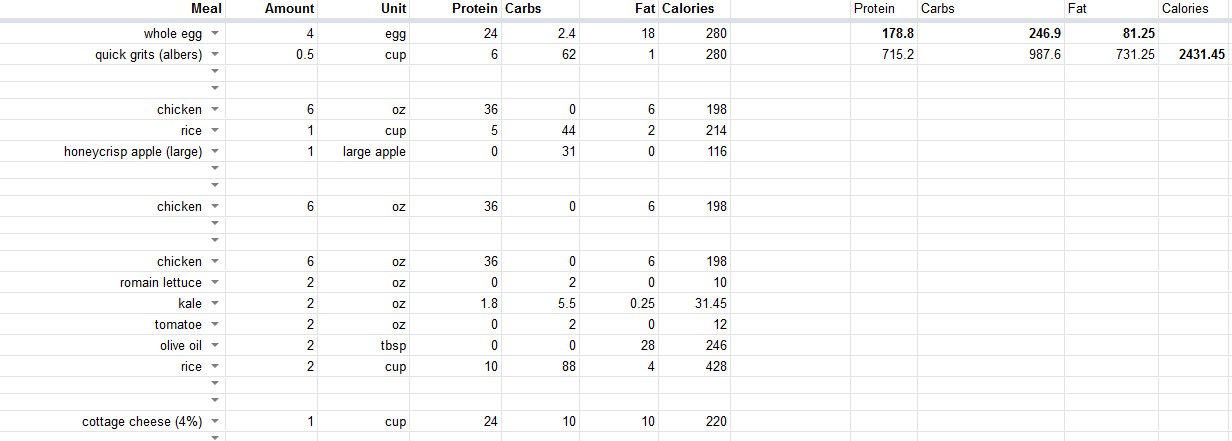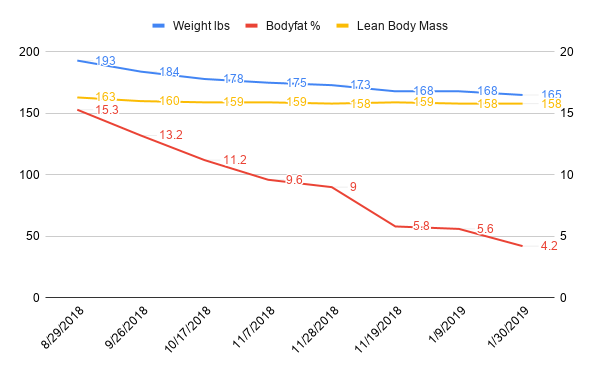My Strange, Cyclic, Fat Loss Diet
As an amateur bodybuilder, I’m often asked by friends, family, and coworkers (other Software Development Engineers) what I do for dieting. I’m writing this so that I can refer people to it in the future since the process is a little hard to explain in detail on the spot. Also, I don’t think there are many (if any) that diet like I do and I’d like to share it. I think the diet can be used by anyone with weight goals and its different enough that it might just be what someone needed after trying other methods without success.
For reference, below is a before/after of the diet for my last bodybuilding show in 2016, as well as a full album to the show to establish creds.

2016 Before and After
Terms
Here is some jargon that people use in the diet/bodybuilding space for reference.
- Macros - Macronutrient values. These are protein, carbs, and fat.
- Maintenance - Refers to the amount of calories you need to maintain your body weight.
- HIIT Cardio - High Intensity Interval Training. In this context, cardio that you divide up into fast/slow sections. I usually use an elliptical cardio machine and alternative between 30 seconds of all out speed and 60 seconds of moderate jogging.
- Refeed Day - A day dedicated to higher carbohydrates during a diet. The idea with these is to give yourself energy to workout. I don’t do these.
- Bulking/cutting - A period of time dedicated to gaining/losing weight.
How it works
The diet is based around a three week cycle. The first week is high carb, low fat. The second week is low carb, high fat. The third week is no carb, no fat. Protein is constant the entire time aside from the last day or two of the third week which is dedicated to fasting. I usually end the third week on a 1–2 day fast as well for longevity reasons. It may not be required but I haven’t tested much omitting it.

Weekly Calorie Breakdown
The goal for most people should be to lose about a pound per week on average. Most of the actual weight loss is happening during the final week. In practice, it turns into comparing your week three lows each cycle to make sure they’re about 3lbs–6lbs lower than the previous. The idea here are as follows.
- Week one gives you energy to workout
- Week two drains your carbohydrate stores in preparation for week three
- Week three burns fat
You will see that the biggest weight drop comes in the third week as well. My first week weight is always much higher than the end of my third week weight as well (4–8lbs). This cycle repeats indefinitely. I diet like this year round because it’s really convenient for me, but that’s personal preference. I just increase/decrease the macros and calories depending on my goals.
Cardio is sparse. The first week has no cardio at all. The second week I usually do 10 minutes of incline walking after each workout, which is usually three or four days a week. The last week sees the most cardio with 10 minutes of HIIT cardio. Mentally, I’m milking this low week for all the fat loss I can get.
Customizing the diet
With the structure in place, the next step is figuring out what to eat. This should be based on a few personalized criteria.
- What you enjoy eating
- What you find convenient
- What you find sustainable
There are also a few key points to keep in mind when you’re planning.
- The absolute numbers aren’t as important as the way you change them over time.
- Consistency is the most important thing.
- You don’t want to go as fast as possible.
- Cardio isn’t the main driver of fat loss, diet is.
If you don’t know what your maintenance is then pick (your body weight * 12) as an arbitrary starting point and iterate each week based on how your body weight responds. If you gain weight then you’re probably too high. If you lose weight then you’re probably too low. As with many things, consistency is very important. If you pick foods that you won’t eat then you won’t be consistent and you won’t get results. I do recommend eating the same thing each day for each of the weeks, at least until you get predictable results from cycle to cycle.
I tend not to track vegetables too much either. After doing diets where I track them and ones where I don’t I didn’t notice any significant difference — even when I was having absolutely massive 3lbs salads with romaine, kale, beets, and tomatoes daily.
Once you have the foods picked out you just follow the plan. You take your weight at the end of each repeating three week cycle. You raise or lower your calories if you’re going too slow or fast at the start of the next cycle. You can play with the macro nutrients for a week or the boundaries of the week. Sometimes I extended my high carb week by a few days because I thought I needed more energy or because it was convenient for a holiday or upcoming event.
What I Do
Here is an example of my most recent high carb week. I was sitting around 180g of protein, 250g of carbs, and 80g of fat, which was around 2400 calories. That’s a little but above my maintenance calories at the time based on my previous diets, which is the goal for the first week.

Diet Example
My own example diets for each week below.
- Week 1 - Looks like a standard bodybuilding diet.
- Week 2 - Removed all of the carbs and replaced with fats I enjoy eating. I tend to require more calories when I’m eating primarily fat for some reason. The calories are higher but I’m still under my maintenance level.
- Week 3 - Removed everything but protein and veggies.
Feel free to make a copy of that google sheet and play around with it. It’s really good for figuring out the number of meals and the macros for each meal. You can even take my example and just switch the foods to ones you like as long as the macros make sense.
I don’t mind eating the same thing every day. In fact, I prefer it. If I eat chicken three times a day then all I need to do to ensure I have enough chicken is cook 5lbs in an Instapot every 3 or 4 days and I won’t have to cook all the time. I value convenience and sustainability above all else. Likewise, I pick rice because of how easy it is to cook. I can make 4 cups at a time in a rice cooker and that lasts the entire first week for me.
Supplements
I’m not sure if these are important or not yet and I think people get hung up on supplements way too much. 95% of your progress is coming from diet and exercise. When you think about taking a supplement, you should be thinking about reducing the time it takes to lose 10lbs of fat from 12 to 11 weeks, you shouldn’t be thinking that it’s going to be the major driver in your diet. That said, here are the ones that I typically use, regardless of whether or not I’m dieting. Really, none of them do much for weight loss. Some do help to counter muscle loss though.
- BCAAs - Sip these during workouts.
- Creatine - Mixed in with my BCAAs during workouts because it’s convenient.
- Multivitamin - Only half of a pack per day because I’m not convinced all of the minerals are needed daily.
- Metformin (prescription) - A few podcasts and books have turned me on to the potential benefits of taking this drug for longevity reasons. I didn’t add it for a fat burning benefit.
- Resveratrol - Also for longevity.
- Fish Oil - Potential cardiovascular health benefits.
Here is an Amazon list that links to the ones I use.
Results
The before/after image above is from my bodybuilding contest prep for my last contest. I competed in Classic Physique and Bodybuilding. I got first overall in Classic Physique and second in Bodybuilding. I suspect I got second in the Bodybuilding division because I experimented with not having a tan, but that’s another story.

Competition Victory
My most recent diet that I tracked numbers for was in August of 2018. I started the diet on 8/29/2018 at 193lbs with 15.3% body fat and finished on 1/30/2019 at 165lbs with 4.2% body fat. So that’s 154 days for 28lbs, or 1.27lbs a week. Here is a full spreadsheet with data on weight, body fat, lean body mass, and my maintenance calories for each three week cycle in the diet.
Usually, 1lbs–2lbs a week is a good target. At that rate, you can be pretty sure that you’re not just shedding muscle and you’re less likely to hit a wall that you have to churn through.
I had access to a fancy body fat measurement device during the diet so I do trust the numbers here more than I would if it were a manual calliper. If they aren’t accurate then they’re at least consistent. I was low enough for that last reading that I was probably outside the bounds of the body types that the equipment was trained to work on, but I don’t think they’re crazy numbers.

Final Diet Progress
Some things to note.
- I kept track of arm size to gauge muscle loss separate from the tool I was using. They went from 17.5" to 16.5" at the end.
- After switching the diet to maintenance levels I was able to get back to 17" arms within 8 weeks. Muscle loss tends to not be very permanent, at least for me.
- Most of the weight loss happened on week three. My weight would jump higher at week one and remain steady until the third week.
- I didn’t do anything special on 11/19/2019’s cycle. Your body just does weird things sometimes.
Review
Bodybuilders tend to stick to something like a weekly diet cycle with refeed days once per week where they’ll raise carbs to last them through the next week’s workouts. That works, but you end up pretty burned out by the end of it because of how monotonous and restrictive it is most of the time. You end up relishing your refeed days to an unhealthy extent in my experience.
For me, the diet I’ve described here was far more sustainable. The first and second weeks felt like I wasn’t dieting at all. The third week was tough but I always had food no more than a week away so it never got too hard to stick to.
In the end, I think it’s good for people to at least realize that there isn’t any one way of dieting. The most important thing is consistency and sustainability. Whatever system you can rationalize that meets those criteria while still leaving you with net negative calories on some fixed, repeating cycle of time will get you to where you want to be.
I’m working on adapting this plan to a bulk right now and I’ll be sure to post a similar article for that. I’m only one week in so far but I have high hopes.